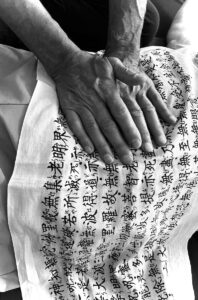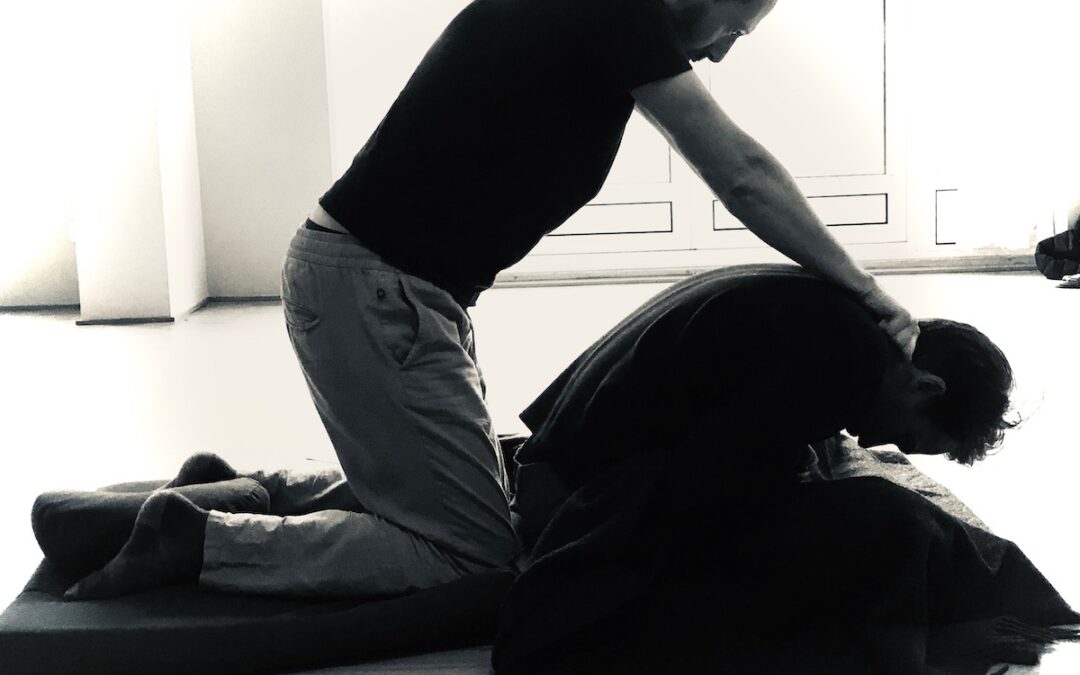A few months ago, I was asked questions about the quality of presence of the shiatsu practitioner and the confidence induced. In particular, how to improve the quality of presence of the practitioner (thank you Caroline for starting the reflections).
During this summer’s Odo shiatsu retreat, the theme I proposed was entitled “Presence of the practitioner, between fear of doing wrong and fear of doing harm”. This allowed us to observe our practices and foster a quality of being as a practitioner, rather than technical learning.
In my career, after having done 6 or 7 times the first year with Kawada Senseï (being an assistant in this first year, I was able to ingest the technique and details which are not very obvious), I realized that I had a certain technical mastery but that my practice seemed to plateau.
How, then, can we go further?
The answer I found was not by looking for new complementary techniques but by digging within myself.
This is what I call in internships and classes: the quality of being.
As my research and experiments progressed, I received feedback on the quality of care which increased with my quality of presence, which itself increased the confidence of the recipient.
Of the presence
The presence of the practitioner comes when we are totally invested in the care we provide. A presence in what happens in our hands, a presence in the reactions of the recipient and a presence in what happens in oneself and around oneself.
This takes some practice time.
From this presence naturally comes absence: the art of stepping aside so that the recipient can take their place again by being autonomous and responsible. It takes a little effort from us to dare to let go and step aside (I will come back to this in another article).

All this is also a question of awareness: becoming aware of what is happening in our hands and also becoming aware that it is not just a body that we are touching. It’s much more than that.
We touch a person through their body.
We therefore have a great responsibility. Our way of touching implies a reaction and an awareness of the person touched about whom we have very little information about the engrammed experience.
Confidence
Presence and efficiency increase with trust.
Trust is multiple.

There is the confidence that comes from being able to repeat the basic techniques at length (read Instant, present, Ichi-go, ichi-e). It’s a very Japanese pedagogy: nothing is too explicit, we watch it done over and over again, we practice tirelessly over and over again, without letting the mind ignite, taking pleasure in each of the gestures, trying to feel the essence of the gesture.
There is the self-confidence that comes from our own experiences, from the way we have digested and nourished them and from our capacity for inner exploration. This is a responsibility that every therapist should have: how to support someone else if they themselves are not doing well.
I’m talking about confidence and not certainties. I sometimes meet people who hide their lack of confidence behind the veil of insolent certainty. Kawada sensei, during our discussions about the practice, told me that a person who appears too confident and too strong was undoubtedly hiding doubts and a lack of confidence.
There is the confidence that makes the receiver completely abandon himself in your hands.
There is also, and this is important, the trust that the practitioner has in the recipient.
Giving a shiatsu is like giving a gift. We offer with a certain abandon, with pleasure and heart, the recipient will do what he can. Thus, each recipient will do the best, depending on their reality, to receive shiatsu, whether for simple relaxation and well-being or for therapy.
Well-being is already therapeutic.
Finally, there is trust. The one who is above all others. That of feeling the movements of Life, that which is present in a tsubo, in the life of the recipient or in one’s own life. The confidence that whispers in our ear to abandon ourselves to what is offered for both the recipient and the giver. The technique no longer has to be thought through, it is done alone through our hands. This is the result of long technical learning and hypnotic repetitions. We can then abandon ourselves to the moments, to the feelings, to the instinct to do well.
It is an immense field of research, experimentation and life stretching out before us.
Let’s practice, practice and practice!




Recent Comments